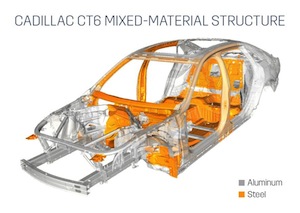 US – While the structure of the sedan is aluminium intensive, a total of 13 materials have been customised for different areas of the car. The materials mix for the CT6, which goes into production later this year at GM Detroit-Hamtramck, Michigan, requires multiple joining methods including spot welds, flow drill screws, self-piercing rivets, laser welding, aluminium arc welding and adhesive.
US – While the structure of the sedan is aluminium intensive, a total of 13 materials have been customised for different areas of the car. The materials mix for the CT6, which goes into production later this year at GM Detroit-Hamtramck, Michigan, requires multiple joining methods including spot welds, flow drill screws, self-piercing rivets, laser welding, aluminium arc welding and adhesive.
“This is the rocket science of automobile construction and manufacturing today,” claimed Johan de Nysschen, president of Cadillac. “With the CT6, we used high-strength aluminum and high-strength steels; lightweight chassis components; we integrate aluminum and steel where it makes sense; we eliminate every gramme of mass possible, while achieving world-class performance.”
The body structure of the CT6 is 64% aluminium, including all the exterior panels, saving 90kg compared with a conventional steel construction. The lower structure is made from 13 high-pressure, die-cast components, along with aluminium sheets and extrusions. The underbody features steel close-out panels on the lower structure to create a quiet cabin without the heavy sound-proofing often needed to compensate for the use of aluminium panels.
High-strength steel (HSS) strategically reinforces the body, in combination with high-strength aluminium in the safety cage plus the front and side impact zones. The structural part of the B-pillar is made from HSS, while a high-strength aluminium impact bar has been added to the rear of the vehicle.
“The structure of the CT6 is one of the most-advanced body systems we’ve ever produced,” said Travis Hester, Cadillac CT6 executive chief engineer.






























